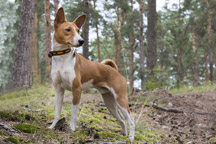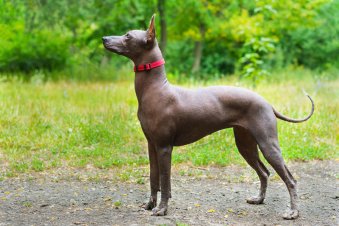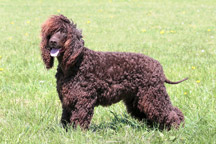Is the Afghan Hound Hypoallergenic?
Indeed it is! Low dander, surprisingly little shedding, and not too heavy on the drooly scale—it’s an amazing hypoallergenic dog!
The Hypoallergenic Afghan Hound Dog
Dignified and elegant, the Afghan dog is a loving yet independent pooch, easily identifiable by its strikingly long and silky coat.
It’s this eye-catching hair covering that deters many allergy-prone prospective pet parents from considering an Afghan—which is a huge shame.
The truth is, they’re highly hypoallergenic.
These pretty pooches hardly shed at all. Although inevitably, there will be some hair loss—it has to be replaced after all—but, it’s remarkably systematic. Generally speaking, adult Afghan Hounds shed every spring and fall, while unspayed girlie dogs lose their hair every season.
Hence, if you have an Afghan bitch, it’s sensible to get her ‘done’ as soon as possible.
Furthermore, unlike some dogs—such as the Alaskan Husky—the Afghan doesn’t have a thick undercoat, which otherwise exacerbates allergy issues. Dander levels are low—with the majority of dried skin and dead hair becoming trapped in the coat, not deposited on your furniture.
Additionally, in keeping with their dignified countenance—these dashing doggies have low drool levels—which can cause allergies in their two-legged parents and siblings.
And, if you require any further evidence of its non-allergenic nature, the AKC (American Kennel Club) considers the Afghan as one of the best breeds for allergy sufferers.
Is the Afghan Hound Hypoallergenic? Contents
Afghan Hound Quick Facts
About the Afghan Hound
Physical Characteristics and Coat of the Afghan Hound
Afghan Hound Temperament
Afghan Hound Grooming and Care
Afghan Hound Training and Exercise
Training Your Afghan Hound
Afghan Hound Health Issues
Conclusion
Afghan Hound FAQs
Afghan Hound Fact Summary
Afghan Hound Quick Facts
| Hypoallergenic Dog: | Yes! |
| Shedding: | Low |
| Drooling: | Low |
| Size: | Large |
| Breed Group: | Hound (AKC), Sighthound (UKC) |
| Lifespan: | 12-15 years |
| Energy Level: | Moderate to high |
| Trainability: | Difficult |
| Family Dog: | Average |

About the Afghan Hound
Distinguished, yet fun loving, independent while affectionate—the contradictory Afghan is far from being a boring pooch.
The Story Behind the Afghan Hound
It’s said that the Afghan Hound was the doggie representative on Noah’s Ark.
Yes, honestly.
Whatever your opinion on the historical accuracy of the Flood story, and indeed whether Afghans were the saviors of the world’s canine contingent—at least one fact lends (a little) credibility to the story.
Scientists from the National Human Genome Research Institute examined the DNA of Afghan Hounds, discovering it’s related to one of the earliest breeds, dating back thousands of years. Hence, at least they were around at the alleged time of the deluge—if not an active participant.
More recent history is no less impressive.
Over the centuries, these powerful pooches became the fast-footed hunting companions of Middle Eastern aristocrats and royal families—including King Amanullah of Afghanistan.
British army officers in this country (fighting their third war against Afghanistan) became aware of the breed, admiring its dignified and almost aristocratic appearance. And, with status being of utmost importance in their homeland, began to bring them back to Britain in the 1920s—where they became the dog to own in gentry circles.
The Afghan rapidly grew in popularity—first in Europe and then across the Atlantic. The (subjectively) hilarious comedian, Zeppo Marx, was one of the first people to import these pooches into the USA—and many of the Afghans in the States today stem from this bloodline. The breed was finally registered with the AKC in 1927.
Physical Characteristics and Coat of the Afghan Hound
Some people refer to the Afghan Hound as the fashion model of the canine world—with its flowing locks, elegant gait, and treating every outdoor saunter as a parade down the catwalk.
Personally, I think that’s a complete load of tosh.
The Afghan is way too refined to be associated with such superficial nonsense.
Instead, in my opinion, the Afghan is a true aristocrat—not a wannabe. Both males and females carry a countenance of dignity, mixed with a little slice of aloofness.
Prominent hip bones and huge paw pads—both working as shock absorbers to help them hunt the mountainous landscape of Afghanistan, cut a powerful and imposing figure. Combine this physique with a 28-inch shoulder height—and you have a one seriously regal pooch.
And, he knows he’s a cut above the peasantry.
A stationary Afghan will stand tall—holding its elongated head high. It will stare motionless into the middle distance, with its almond-shaped eyes—like a member of the landed gentry surveying their estate.
Yet, although with the posture of a king—it’s perhaps the Afghan’s coat that is the most arresting feature of all.
The coat is incredibly thick, yet the silky and flowing texture gives a feeling of lightness. While amazing to look at, this fur served as valuable protection in the cold climate of the Afghan’s homeland.
All of the Afghan, apart from its face, is covered in this hair—including the feet and its long ears.
The most typical colorings of this posh pooch are:
- Black.
- Silver and black.
- Tan and black.
- Blue.
- Cream.
- Cream and blue.
- Red.
- Silver.
- White.
Often, Afghans have a back ‘face mask.’ Alternatively, they may sport facial hair akin to a mustache—varieties known as ‘mandarins.’
Just a quick piece of advice.
If you’re thinking of owning a hypoallergenic Afghan, remember this—they’re not little pooches. Should you be looking for a more compact canine, check out our guide to the perfect small hypoallergenic dogs.
Typically, the Afghan Hound size is around 25-28 inches high at the shoulder and it weighs around 50-60 pounds.
Afghan Hound Temperament
Because of their regal appearance, many Afghans can sometimes exhibit signs of being a little—well—distant.
They’re independent and can be standoffish—even with their main pet parent. However, they might then suddenly drop this guard (usually if no-one else is watching) and become incredibly loving, adorable, clownish, and playful—only to turn aloof again when they remember who they are. This may not make them the ideal family-friendly dog.
In this way, they can be compared to their feline counterparts—demanding attention on their terms. One minute they’re as soft as babies, the next they will look down on you with an air of condescension.
However, it’s this personality that makes them the favorite of Afghan devotees. They’re not lap dogs or subservient beasts—they are individual and strong-willed characters.
Conversely, they can also be quite sensitive and timid at times. Too much harsh correction or loud noises (even from children) and the Afghan can become shy and forlorn.
Around strangers, they are quite wary. Hence, don’t expect your Afghan to bound up to your home visitors in a carefree manner. They’re more likely to stand and stare at them while they wonder who this new person is, trespassing on their land.
Outdoors, be careful.
As one of the oldest breeds known, their genes have altered little since their wolf days. Hence, they have a seriously high prey drive and may not mix well with other small animals—hence the Afghan’s original function as a hunting dog.
Keeping them on a leash outside of the home is essential. If they see the movement of what they consider potential prey, they will hit pursuit mode, leaving you poochless.
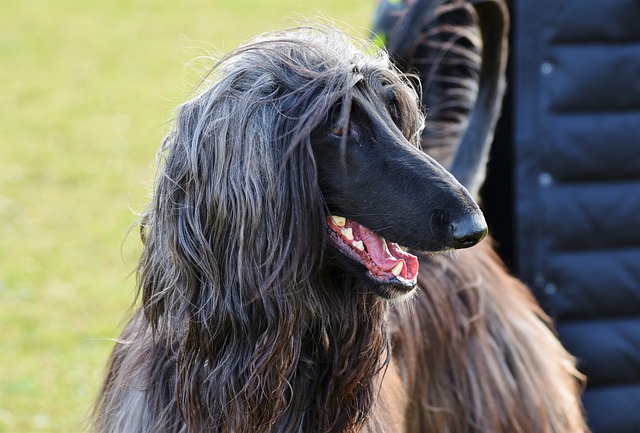
Afghan Hound Grooming and Care
Looking After Their Coat
Undoubtedly, Afghan Hounds are strikingly attractive dogs. But beauty comes at a price—in this case, your time.
As puppies, you have little to worry about.
Afghan pups sport short and fuzzy coats, often incorporating weirdly adorable facial hair, known as ‘monkey whiskers.’ As such, they require very little attention as youngsters.
Then, it all changes.
The spectacular silky and long coat of both adolescent and adult Afghans means a heck of a lot of grooming. If you’re not happy putting in the several hours per week of brushing and combing they need, these pooches will not be your ideal pet.
The voluminous hair is liable to knot and tangle, unless you give it a good going-over every day. Ensure you take the comb right back to the skin, to address the undercoat. Furthermore, you’ll need to concentrate on the areas between the legs and under the tummy—as they’re likely to mat.
As a dog that needs daily walking, the coat acts as a magnet to dirt and debris from your strolls. Hence, brushing, combined with frequent bathing with shampoo and conditioner, is essential.
Nails and Teeth
Dogs can be a little touchy about their paws—especially Afghans. Let’s face it, if you were a highly respected aristocrat, you’d find it highly unnerving for some serf to grab your tootsies and begin fiddling with them.
Therefore, it’s important to accustom your pooch to having his or her nails trimmed from a puppy. In fact, the same advice applies to grooming—although as a pup it’s not essential.
A couple of times a month, trim your Afghan’s nails. Or, if you hear them ‘clicking’ on the floor, then that’s a sign they’re too long.
Afghans don’t suffer from teeth issues any more than other breeds—but this doesn’t mean it’s an area that should be neglected. Clean your pooch’s teeth twice a week, with a brush and doggie toothpaste.
Similar Dog Breeds To Afghan Hound
Afghan Hound Training and Exercise
As I mentioned earlier, the Afghan was originally a mountain hunting dog—and, as such, you need to take this into account in all aspects of exercise.
Firstly, due to their genetic outdoorsy nature, they need extensive daily walks. A couple of 45-minute excursions should be sufficient, although—preferably—you should aim to give them around two hours in total.
This love of being outside means that they’re not ideal apartment doggies, even though many loving owners successfully keep them in these smaller residences. It means that you need to be prepared to leave the house at a moment’s notice—when your Afghan becomes boisterous, bored, or agitated.
Reflecting their hunting style, Afghans are built for short bursts of energy, not marathons. This means that they’re not the greatest running partners. Elongated walks, finished off by a few short sprints, are the best solution.
So, take a leisurely stroll with your Afghan for around 40 minutes—and complete the session with some games of fetch.
But, be careful.
As you know, Afghan Hounds love to chase, but—given the choice of a ball and a squirrel—the fluffy-tailed creature will win every time. Therefore, ensure that any areas where you allow your pooch to run off the leash are enclosed. Obedience training, and expecting your Afghan to stay or return on command is difficult to say the least.
If you’re lucky enough to have a yard or garden, your Afghan will be quite happy to put in some additional exercise off their own back. They’re known for inventing their own outdoor games. You’ll look out of the window and witness your pooch tearing up and down your lawn—seemingly in pursuit of some imaginary prey.
Again, make certain the area is safe—and that means a high fence or wall.
These hunting dogs are lean, muscular, and powerful—making them excellent jumpers. While excellent for agility classes, it can be a nightmare if he or she makes it into your neighbor’s garden or out onto the highway.
Hence, if you’re after a somewhat more reserved and less challenging pooch, it might be wise to check out the other hypoallergenic dog breeds.

Training Your Afghan
It’s reported that the Afghan Hounds weren’t just capable of tackling a gazelle or an antelope—they could also hold their own against snow leopards.
As such, this pooch needed to be independent and think on its own (four) feet, adapting to the demands of the hunt as needs required. I mean, if the Afghan was facing off against a huge, incisor-toothed feline, standing around patiently waiting for its owner to give fighting instructions wasn’t the best course of action.
This genetic trait remains within the Afghan—meaning they improvise and make their own decisions—thus making them notoriously difficult to train.
Dr. Stanley Coren, a renowned neuropsychologist, studied the cleverness of over a hundred different dog breeds. In his book, The Intelligence of Dogs (1994), he published his results—and the Afghan came last on the intelligence scale.
However, this is somewhat misleading.
What Dr. Coren was referring to, when he used the word intelligence, was the ability of a particular pooch to understand and obey commands—not solve problems.
Hence, an Afghan may be capable of designing and building a quantum energy-powered space rocket—but the problem is, if you ask it to do so, it will ignore you and chase a rabbit instead.
So, can you actually train an Afghan?
The answer is yes, but you need to start early and be very patient.
Basic obedience training needs to begin no later than seven months old—while your doggie’s personality is developing and it’s more pliable and keen to learn. Consistency and tenacity is the key.
Afghans respond to positive reinforcement—punishing or coercing will just have a negative effect. Many trainers say that these pooches learn the quickest when they understand they’re at the bottom of the family hierarchy—so you should ensure they know who’s boss.
There are numerous ways to ensure your Afghan knows that—like Jimmy in the Shangri-Las song—you’re the leader of the pack (if you’re under 50 years old—Google it!).
However, three of the key tricks are:
- Always enter through doorways in front of your doggie.
- Eat your dinner first, and then feed your Afghan.
- If the dog is lying in your path—make him or her move, rather than walking around the pooch.
With your role as top-dog established—and with a little determination—you should be able to teach your Afghan the basic commands of sit, stay, and heel.
Nevertheless, here’s something to bear in mind.
You may have wonderful success in the familiar confines of your living room. But, when you take your pooch outside, with one glimpse of a scurrying furry animal, your dog will disappear—seemingly deaf to all the commands you thought you had successfully instilled.
There is, at least, some good news.
Housebreaking is no more difficult than any other breed. In fact, some anecdotal evidence suggests that Afghans may be easier than many other doggies.
Perhaps it’s because they don’t want to destroy their outward countenance of dignity and regality by peeing on the carpet. Or maybe they just want to be outside and mark their territory, to deter those pesky leopards.
Whatever the reason, as long as you start house training your puppy from day one, there shouldn’t be any issues.
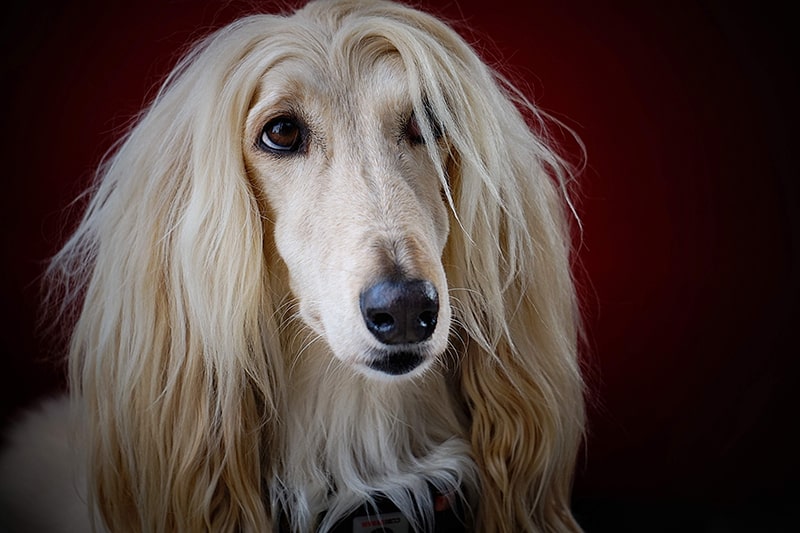
Afghan Hound Health Issues
Generally speaking, the average age of an Afghan at death is 12 years—typical of most dogs of this size.
According to the Kennel Club, the three most common causes of this type of pooch’s demise are:
- Cancer – 30.8 percent.
- Old age – 20.3 percent.
- Heart failure – 10.5 percent.
That said, there are some health conditions that can affect the Afghan Hound more than many other breeds.
Hip Dysplasia
Sometimes, the ball of the femur (thigh bone) and hip socket don’t grow at identical rates—meaning that the affected leg doesn’t fit perfectly into the joint—an issue known as hip dysplasia.
If you see your Afghan having a reluctance to run or walk, or developing a slight ‘bunny-hopping’ stride, speak with your veterinarian. If hip dysplasia is diagnosed, you may be recommended medication, diet supplementation, weight control, or a surgical procedure.
Chylothorax
Although rare, this condition has a relatively high incidence in the Afghan breed.
In this disease, the thoracic ducts leak—releasing fluid into the doggie’s chest cavity. The excess pressure causes the dog’s lungs to twist—causing serious breathing problems.
Hence, should you witness your pooch having difficulty catching its breath, a heaving chest, or strange gurgling noises—immediately take to the vet. While serious, Afghans display a good recovery rate if treated early.
Bloat
As with other deep-chested pooches, Afghans can experience GDV (gastric dilation-volvulus), also known as twisted stomach, or bloat.
This condition appears suddenly and can affect an otherwise perfectly healthy Afghan. Although the precise cause isn’t known, it often develops after consuming a large meal, or drinking copious amounts of water, immediately after vigorous exercise.
Symptoms of bloat include:
- An enlargement of the abdomen.
- Chronic retching.
- Excessive salivation.
- Extreme restlessness.
A doggie with bloat may experience pain, and might whine or snap if you press on his or her tummy. In any suspected case of GDV—seeing a veterinarian immediately is essential.
Just one more quick point regarding Afghan Hound health.
With low stores of body fat, Afghans are highly sensitive to anesthesia. For this reason, many experts suggest locating a sighthound-specific veterinarian for surgical procedures.
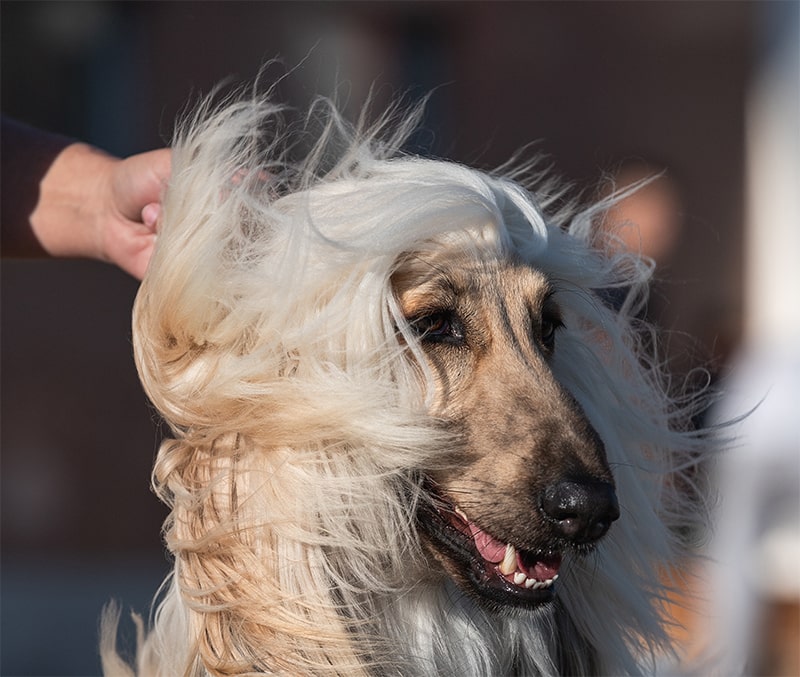
Conclusion
The Afghan is perhaps the most royal of all the dog breeds—and knows it.
This proudly princely pooch carries an air of grace and dignity, exemplified by its striking coat, raised head and elegant posture.
Eager to hunt and a keen walker, it’s the ideal doggie for those pet parents who want to enjoy the great outdoors with their fur baby—and be noticed.
They give love and can be highly affectionate—as long as you understand it’s on their terms. Fiercely independent, they have a character perhaps more individual than any other canine companion.
And, for those who suffer from allergies, it’s a perfect choice.
With hardly any shedding, a low dander count and little or no drooling, the Afghan Hound hypoallergenic dog shouldn’t aggravate any intolerances.
Afghan Hound FAQ
Do Afghan Hounds Shed?
Like all dogs, they shed a little—but the Afghan has a seriously low shedding volume.
Daily grooming will ensure that you remove any dead or stray hairs—and that they won’t be deposited on carpets or furniture.
The Afghan Hound shedding periods include every fall and spring, and after every season for unspayed bitches.
Is There an Afghan Hound Short Hair Breed?
No.
While the Afghan puppy will display short and fuzzy hair for the first few weeks, this will gradually grow into the long and silky coat that the breed is known for.
You can, naturally, cut the hair all the way back to a ‘puppy cut’—but then you will lose the distinctive fur that makes this beautiful pooch so unique.
Are Afghan Hounds Good Family Dogs?
Yes—but you need to take some precautions.
As loving (usually) and playful pooches, Afghan hounds cope well in family situations, although a little care is necessary around children.
An Afghan puppy will bond easily with children—and as they grow up together, issues are unlikely. However, if you’re bringing an adolescent or adult dog into the family—introduce them slowly.
Being sensitive, they can easily be startled by loud noises or unexpected boisterous behavior. So, take time to discuss with your children how to act in the first few months, in the presence of your new fur baby.
Are Afghan hounds Affectionate?
Yes—when they want to be.
Afghans will give you a great deal of love and attention—but don’t expect them to become puppy-like every single time you stroke or praise them. Sometimes they can act a little aloof—but half an hour later they’re all over you. That’s half the attraction of this independent pooch.
How High Can an Afghan Hound Jump?
As a muscular, lean, and strong canine, the Afghan can jump to a height of around seven feet—from a standing position.
Hence, your yard or garden will require a high fence to prevent any Steve McQueen-esque great escape issues.
Afghan Hound Fact Summary
| Breed | Afghan Hound |
| Other Names | Tazi Spay, Sage Tazi, Tazi, Baluchi Hound, Shalgar Hound, Barakzai Hound, Kabul Hound, Galanday Hound, and Balkh Hound |
| Height | 25-28 inches (63.5-71 cm) |
| Weight | 50-60 pounds (22.6-27.21 kg)
|
| Lifespan | 12 to 15 years |
| Temperament | Proud, aloof, sensitive, thoughtful, dignified, intermittently clownish and independent |
| Colors | Black, silver and black, tan and black, blue, cream, cream and blue, red, silver, white. May have a black mask, or Fu-Manchu mustache. |
| Coat | Eye-catchingly silky, long, and thick |
| How much grooming? | The Afghan Hound has a coat that requires regular bathing and brushing to maintain its beauty. Routine maintenance is the key to managing a spectacular appearance. |
| Do Afghan Hounds Shed? | Very low hair loss |
| Dander levels | Minimal, with the ongoing routine maintenance that this breed demands |
| Saliva | Low tendency to drool or dribble |
| Energy levels | Moderate to high |
| How much exercise do they need? | 1.5 to 2 hours per day |
| Health problems | Hip dysplasia, bloat, and chylothorax. Additionally, due to their low fat levels, Afghan Hounds are highly sensitive to anesthesia |
| Good for an apartment? | As long as they have two long walks per day, they’re suitable for apartment living. Although, ideally, a yard or garden will allow the Afghan to exercise freely off the leash |
| Suitable for kids? | Yes, if introduced into the family as a puppy. Older dogs may require some patience, and the willingness of the children not to be too boisterous. |
| How much do they bark? | Low tendency to be vocal—although they can bark if a stranger enters your home |
| Can they be left alone? | This is not a breed that likes to be alone and it can suffer from separation anxiety if you’re absent for long periods. They can also become highly strung, bored, and timid if not given sufficient mental stimulation and physical exercise |
| Intelligent? | Yes—although they don’t always display it |
| Trainable? | Their independent and stubborn nature makes them difficult to obedience train |
| Interesting fact | Barbie, the doll beloved by millions of little girls, has a pet Afghan Hound, called Beauty |
| How popular as a pet? | Ranks as the 113th most popular breed by the AKC. Additionally, because of the Afghan Hound hypoallergenic nature—they’re sought after by those who suffer from pet allergies |


